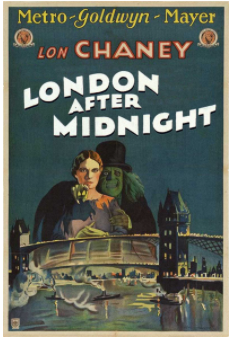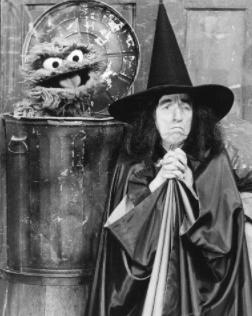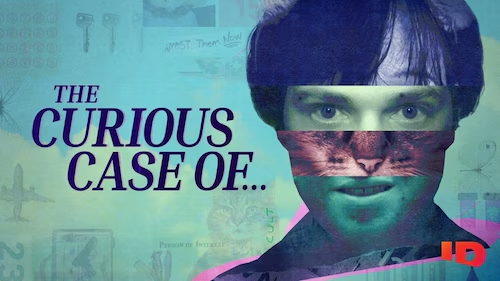Lost in Time: A Review of Lost and Forgotten Media
According to the Dutch film archive Deutsche Kinemathek, it is estimated that roughly 80-90 percent of silent-era films are lost and most of them will likely remain lost forever.
While the reason for this varies, quite possibly the biggest reason why so many silent films are lost is because of the lack of effort put into preserving them. Back in the silent era, films were seen as generally worthless. So much so that entire reels have been reused again and again. It’s because of incompetence such as this that we’ve been stripped of would-be classics such as Tod Browning’s London After Midnight and El Apostol, which is considered by many to be the first feature-length animated film.
 Promotional poster for the now lost “London After Midnight” (circa. 1927)
Promotional poster for the now lost “London After Midnight” (circa. 1927)
Even after the silent-era and film preservation was taken slightly more seriously, nothing much stopped sound-era films from becoming lost. A bizarre yet popular example is the 1974 film Him about a young gay man who develops a romantic obsession with Jesus Christ and uses this obsession to understand the “hidden meaning” of the four Gospels. After its release and a slew of negative receptions, it was relatively unknown until it was mentioned in the book The Golden Turkey Awards. It’s worth mentioning that a note in the book states that of all the films detailed in the book, one of them does not exist. While it was believed that this referred to Him, it was revealed to be referring to another film dubbed Dog of Norway. From here, nothing is known about Him, except for the actor who played Jesus, its release date, and the name of the director, Ed D. Louie (which is believed to have been a pseudonym).
While a multitude of films such as Him, London After Midnight, and El Apostol are lost to time, other mediums have also been plagued by lost works. Aside from film, what is arguably the second most prevalent example is television. A rather famous instance is not one but two different “Sesame Street” episodes: one that follows Margaret Hamilton’s Wicked Witch from The Wizard of Oz visiting Sesame Street and another that revolves around the subject of divorce featuring the character Snuffy and his parents. Both of these episodes were pulled due to outcry from parents, though they were both later screened at a “Lost and Found” event at NYC’s Museum of the Moving Image. But aside from this event, both remain lost with only screenshots surfacing.
 A photograph taken from the set of the infamous Sesame Street episode, featuring Margaret Hamilton and Oscar the Grouch (circa. 1976)
A photograph taken from the set of the infamous Sesame Street episode, featuring Margaret Hamilton and Oscar the Grouch (circa. 1976)
Another example of not only lost television but of a lack of preservation is the various lost episodes of the long-running hit BBC series “Doctor Who“. Between 1967 and 1978, the BBC had a habit of wiping and reusing tapes. These tapes contained episodes of various TV programs, including “Doctor Who“. It’s this carelessness that led to a whopping 97 episodes from the series’ first six years missing.
Shifting away from both the big screen and television screen, another medium greatly affected is video games. One of the most mysterious instances is of a game only known as “Yeah Yeah Beebiss 1” for the Nintendo Entertainment System. Apart from its strange title and the presence of its name in various catalogs, nothing is known about it and nobody has come forth to say that they own a copy. Though, it has been speculated that the title is merely a poor translation of a Japanese video game.
A more recent case is that of “Distrust”, an early version of the popular visual novel game, “Danganronpa”. Developed sometime in the late-2000s, “Distrust” kept the same basic premise and characters as “Danganronpa”, but there were many aspects that differed; the signature pink blood the franchise is known for was a more realistic crimson and the gameplay featured a more decision-driven story, where the player’s choices lead to other characters’ fates. After being scrapped and reworked into “Danganronpa”, any copies of “Distrust” have never resurfaced and all we’re left with is brief footage and screenshots.
 A photo of what appears to be a demonstration of “Distrust”, displaying the various features of the game (circa. 2007)
A photo of what appears to be a demonstration of “Distrust”, displaying the various features of the game (circa. 2007)
At this point, you know of just a few of the pieces of lost visual media, such as films, TV shows, and video games. But if these modern mediums can be lost to time so easily, then the realm of literature is arguably a much deeper rabbit hole. Writing has been around almost as long as mankind itself, so it is inevitable that the majority of everything written throughout history would become lost to time. Quite possibly the most famous example of lost literature is a series of excerpts from the epic poem “Beowulf”.
“Beowulf” is an epic Anglo-Saxon poem written by an unknown author about a hero named Beowulf who goes on quests to battle monsters and dragons. Time and time again, “Beowulf” has been considered one of the most important pieces of Old English literature. Due to its age, the preservation of the original manuscript has proven to be very difficult and was even damaged in a fire at the Ashburnham House in 1731. The missing pieces include portions as small as a few words or sentences to an entire excerpt from near the end of the poem. It’s also worth mentioning that the story was mostly passed down and told orally, so we’ll never know if the author really included every detail of the story in the manuscript.
While an ancient Anglo-Saxon poem or an unknown romantic film going missing is rather believable, one piece of lost media is bound to turn a few heads: entire lost Biblical quotes, originating from a source known as “The Q Gospel” (or alternatively “Q Source” or “Q Document”). Though mostly dismissed as more of a theory, it states that out of the four gospels (Matthew, Luke, Mark, and John), Matthew and Luke have overlapping writing that isn’t shared with the other gospels. These overlaps are said to be quotes from Jesus. The theory claims that Matthew and Luke got these quotes from another source, known as the “Q Gospel”, “Q Source”, etc. While there are a sea of theories explaining “Q”, in the end, the probability of it ever resurfacing is near zero since it may have existed only verbally.
While it may seem that something as surprising or provocative as “Q” could be the deepest level lost media can extend to, that is not the case whatsoever. There are many other significant historical pieces of lost media that will also leave you in awe. One of these instances is the missing Apollo 11 tapes.
 The famous photograph of Buzz Aldrin standing on the lunar surface (July 10, 1969)
The famous photograph of Buzz Aldrin standing on the lunar surface (July 10, 1969)
History was made on July 20th, 1969 when Neil Armstrong and Buzz Aldrin touched down on the Moon. And while many of us have seen footage of the actual touchdown, it comes as a shock that the original SSTV tapes are lost. The reason for this, hilariously enough, is because NASA likely wiped the tapes for reuse, similar to TV Shows of the time. This has sparked a fair amount of conspiracy theories, most notably the theory that the moon landings were faked and filmed in a studio.
While every example of lost media explained here makes it seem hopeless for any of it to ever be found, that is far from the truth. In more recent times, thanks in large part to the internet, interest in these pieces of lost media has piqued and many people frequently come together to find various pieces of lost media.
A notable example of lost media being found again is the rediscovery of the song “Ready ‘N’ Steady” by D.A. The song first appeared on Billboard’s Bubbling Under the Hot 100 chart in 1979 but shortly fell off thereafter. Since then, not a trace of it has emerged and it was often considered a “phantom record”, a record that simply does not exist. It wasn’t until recently it was discovered that one of the original artists, Jim Franks, came forward and gave a copy of the song to Paul Haney, who played the song for the first time in decades on the radio show “Crap from the Past”. And it’s from here that “Ready ‘N’ Steady” can now be listened to online.
Quite possibly one of the most famous examples of lost media being rediscovered is the once-lost “Sesame Street” skit known simply as “Crack Master”. The short revolved around a young girl who made friends with cracks in her room’s walls that took on the shapes of various animals. Soon, the girl and her friends run into a terrifying, malicious being made up of these cracks known as The Crack Master. After numerous accounts of the short surfaced on online message boards, a rigorous search effort kicked off. Eventually, one man came into possession of a VHS copy of the short but, contractually, was not allowed to share it online. As search efforts continued with various potential leads turning up short, the founder of the Lost Media Wiki, known by Dycaite, received a digital file from an anonymous source and within the file was the long sought-after short. While it is bizarre how it all came together, the efforts of people online had finally unearthed “Crack Master”.

Kevin McKenna is an up-and-coming journalist whose works have received many acclaim from teachers and students alike. He is currently a student at Roxbury...





